Description
Intelligibility, Oral Communication, and the Teaching of Pronunciation
Cambridge Applied Linguistics Series
Author: Levis John M.
An intelligibility-based approach to teaching that presents pronunciation as critical, yet neglected, in communicative language teaching.
Language: English
Subjects for Intelligibility, Oral Communication, and the Teaching of...:
Approximative price 97.81 €
In Print (Delivery period: 14 days).
Add to cart
Intelligibility, Oral Communication, and the Teaching of Pronunciation
Publication date: 10-2018
316 p. · 15.6x23.5 cm · Hardback
Publication date: 10-2018
316 p. · 15.6x23.5 cm · Hardback
Approximative price 34.17 €
In Print (Delivery period: 14 days).
Add to cart
Intelligibility, Oral Communication, and the Teaching of Pronunciation
Publication date: 10-2018
316 p. · 15.2x22.7 cm · Paperback
Publication date: 10-2018
316 p. · 15.2x22.7 cm · Paperback
Description
/li>Contents
/li>Biography
/li>
A proper understanding of intelligibility is at the heart of effective pronunciation teaching, and with it, successful teaching of speaking and listening. Far from being an optional 'add-it-on-if-we-have-time' language feature, pronunciation is essential because of its tremendous impact on speech intelligibility. Pronunciation dramatically affects the ability of language learners to make themselves understood and to understand the speech of others. But not all elements of pronunciation are equally important. Some affect intelligibility a great deal, while others do not. With a strong emphasis on classroom practice and how pronunciation teaching can be more effectively approached in different teaching contexts, this book provides an important resource for pronunciation researchers, with a distinctly practical focus. It shows how intelligibility research informs pronunciation teaching within communicative classrooms, enabling language teachers to incorporate intelligibility findings into their teaching. Professionals interested in oral communication, pronunciation, and speech perception will find the book fascinating.
Part I. A Framework for the Teaching of Spoken Language: 1. Intelligibility, comprehensibility and spoken language; 2. Setting priorities: what teachers and researchers say; Part II. Word-Based Errors and Intelligibility: 3. Segmentals and intelligibility; 4. Consonant clusters and intelligibility; 5. Word stress and intelligibility; Part III. Discourse-Based Errors and Intelligibility: 6. Rhythm and intelligibility; 7. Intonation and intelligibility: the roles of prominence and tune; Part IV. Teaching and Research Approaches to Intelligibility: 8. Teaching for intelligibility: guidelines for setting priorities; 9. The intelligibility-based classroom; 10. What should and should not be taught – an intelligibility-based approach.
John M. Levis is Professor of TESL (Teaching English as a Second Language) and Applied Linguistics at Iowa State University. He is co-editor of Social Dynamics in Second Language Accent (2014), The Handbook of English Pronunciation (2015), and Pronunciation: Critical Concepts in Linguistics (2017), and is the founding editor of the Journal of Second Language Pronunciation.
© 2024 LAVOISIER S.A.S.




